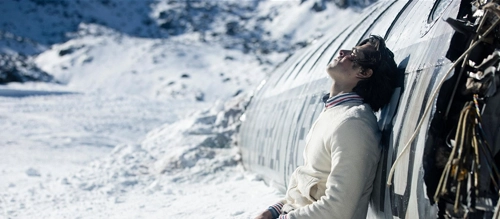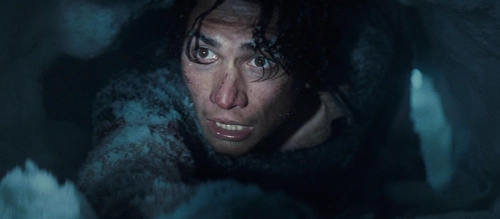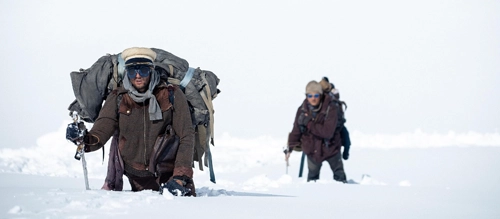Society of the Snow (2023) Review

Society of the Snow / La Sociedad de la Nieve (2023)
Director: J.A. Bayona
Screenwriters: J.A. Bayona, Bernat Vilaplana, Jaime Marques, Nicolás Casariego
Starring: Enzo Vogrincic, Agustín Pardella, Matías Recalt, Esteban Bigliardi, Diego Vigezzi, Fernando Contingiani
“This is a place where life is impossible. Out here, we are an anomaly.”
On October 13, 1972, a plane carrying 45 passengers crashed. After 72 gruelling, unimaginable days, some survived. Nominated for Best International Feature Film at the 2024 Academy Awards, Society of the Snow tells the unthinkable tale of resolve, moral questions, and rethinking of relationships among the victims and survivors.
Flight 571’s devastating crash and subsequent descent into further horror has been brought to the screen before, notably by way of Frank Marshall’s 1993 Hollywood production Alive and through genre pieces inspired by the real events such as Showtime’s ‘Yellowjackets’. Society of the Snow stands apart. It bears witness to the horrors on the mountain, but it does not dwell on them – this film seeks to understand and honor the victims and the survivors. It informs us that, in order to survive for another day each day after the crash, the dwindling survivors had to reinvent what it meant to be human.
Society of the Snow, while depicting real-life horrors such as cannibalism, contorted body parts, frozen eyeballs, and a plane crash, firmly remains a drama. The makeup and costumes that depict these injuries add to the urgency and realism but do not attempt to gross-out the audience, and importantly to the director and crew, who got to know some of the surviving victims, it does not exploit the story or try to make it into something purposely controversial or horrific. It focuses on the characters and their reactions, emotions, and the lifelong bond they create on that mountain, rather than the specific actions they took in order to eat and survive. It also does not try to make some characters into heroes and others into villains or even simply victims. The film is sure to depict that no one would have survived had they not learned to exist in a new way, essentially forming their own society, just as the title suggests.
The film is narrated by one of the longest holdouts, Numa Turcatti (Enzo Vogrincic), who gives a sobering voice to the victims. This choice allows us to understand the group’s inner turmoil along with the more obvious terrors of survival. While the voiceover aids in exposition, it also allows for the discussion and observation of the more philosophical aspects of the movie. They know that no one should be able to survive where they are surviving – and that no one had before. Everyone is a frozen teardrop away from breaking down, but they cannot, because they must remain strong for each other. There is a memorable moment in which Numa says how badly he wants to cry, and laugh, and dance, and a fellow survivor tells him that he can and he will. They show each other strength through sharing their emotions.
According to The Independent, “The film’s title is how the survivors referred to themselves up on the mountain, where survival relied on them working together as equals. If they stood any chance of leaving the mountain, no-one could be more important than anyone else.” Society of the Snow appears to seek, above all, to pay respect. There are diverging survival tactics and combative personalities, but ultimately they reconcile and seek to understand one another. A major turning point in the film is a scene in which characters discuss how they could proceed when they run out of food, and one man leads the way and makes a decision for himself. Some follow, others are disgusted, but they try to keep each other alive and help each other to reconcile their personal morals and religious beliefs with the realities of survival.

Society of the Snow is paced well; even if some scenes are agonizing, it is not for lack of content or without purpose. Some have critiqued its length, which at 144 minutes is not a quick watch. It forces you to sit with the survivors in the cold and wind, huddled together for survival. It actually speeds through some of the later days of survival on the mountain, as the unimaginable becomes routine. The first 15 minutes, before the crash, show a charmed, golden-hued life that is a stark contrast to the bitter mountain life that will soon be endured. There are trials and failures to get rescued, frozen body parts, heaving sobs. But this is also contrasted with joy, which brings balance to what could easily be a demoralizing viewing experience. After a storm that lasts several days and leaves the survivors huddled inside the fuselage until it passes, despite deaths and injuries, there is shortly thereafter a scene in which the young men run around making snow angels. They are weak, but not broken.
Director J.A. Bayona has professed his love for the book that his film is based upon. Interestingly, given how different the approaches to the films are, a passage in the book even inspired the title of his other film The Impossible. He had wanted to make the movie for more than a decade and he, the actors, and the crew, conducted hundreds of hours of interviews with the living survivors and families of the victims in an attempt to capture their attitudes and what it really was like to be there, and how it felt looking back on the event. “Society of the Snow: The Definitive Account of the World’s Greatest Survival Story” was written by Uruguayan journalist Pablo Vierci, who actually grew up with and knew many of the passengers. This film is notably the first time that all of the survivors and the victims’ families agreed to allow their real names to be used. One living survivor, Carlitos Páez, plays his own father in a haunting reunion scene.
Many disaster movies based on true stories – Bayona’s The Impossible included – make the convenient but costly mistake of zooming in too close and telling only one perspective on a larger disaster. Instead of focusing on one or a handful of the 45 passengers, which is the strategy that the 1993 adaptation Alive took, Society of the Snow attempts to show the victims’ personalities and how they sometimes clashed but ultimately came together. There are, however, benefits to zeroing in on a smaller group, because we can more easily distinguish between the characters and become acquainted with their similarities and differences.

Society of the Snow’s refusal to leave any man behind, in real life or in the screenplay, leads to character development that is at times clunky. In order to distinguish between members of such a large, half-frozen mass of characters, sometimes character is delivered through exposition, voice-over explanation, or through conflict and conversation. Even so, the film does leave room for nuance and heavy conversations contrasted with moments of levity. The young, native Spanish-speaking, mostly unknown cast soon becomes endearing through triumph and trauma, the cast inviting us in through their raw performances.
The film is as confidently made in its few but memorable action sequences as its quiet conversations and depiction of long subzero nights. Bayona’s intent to maintain respect and accuracy is tangible in its deliberate pace and lack of manufactured drama and action. The plane crash takes place less than 20 minutes into the movie, where in just a few minutes the plane hurtles towards Earth in a heart-stopping, bone-crushing sequence. Plane crashes in films are not unique, whether fictional or biographical, from Sully to The Flight of the Phoenix, but its realism is effective. This is absolutely essential to get right, and it is engrossing even on a small screen, streaming on Netflix. The sound design is spectacular and the off-kilter visuals catch small moments of terror, panic, and prayers. It is an unforgettable moment that sets the tone for the next two hours that cover a little over two months of survival at 11,500 feet in the Andes.
There is a lot of discussion present in Society of the Snow about faith and whether God will forgive them for doing what was necessary to survive. Others ask if God will forgive them for allowing themselves to die. One takes a radically different approach that encapsulates a major theme of the film: that the only way for any of them to survive another day, let alone get out and go home someday, is to believe in each other. This character says that there is an entirely different God “that exists only here. Only in these people.” Early in the film, they take the sacrament and a sermon tells about Jesus’s 40 days and 40 nights in the desert that tested his faith. The act of being so determined to survive, or to give others the strength to survive through sacrifice, is a powerful and timeless lesson of resilience and how people can care for one another in the most extreme circumstances. “I have more faith than I ever had in my whole life.” This faith comes not from the sermons they grew up attending on the other side of the world, but from their faith in each other and themselves, in humanity.
Society of the Snow is an unmissable awards season watch. It is an unforgettable film about humanity finding the light in the darkest of situations, and finding faith in each other to survive the impossible.
Score: 20/24
By Kyra Lieberman
You can support Kyra Lieberman in the following places:
Portfolio: Kyra Lieberman
Blog: & More
X (Twitter): @kyralieberman
Instagram: @kyralieb

